Your Ultimate Guide to Family Camping Essentials
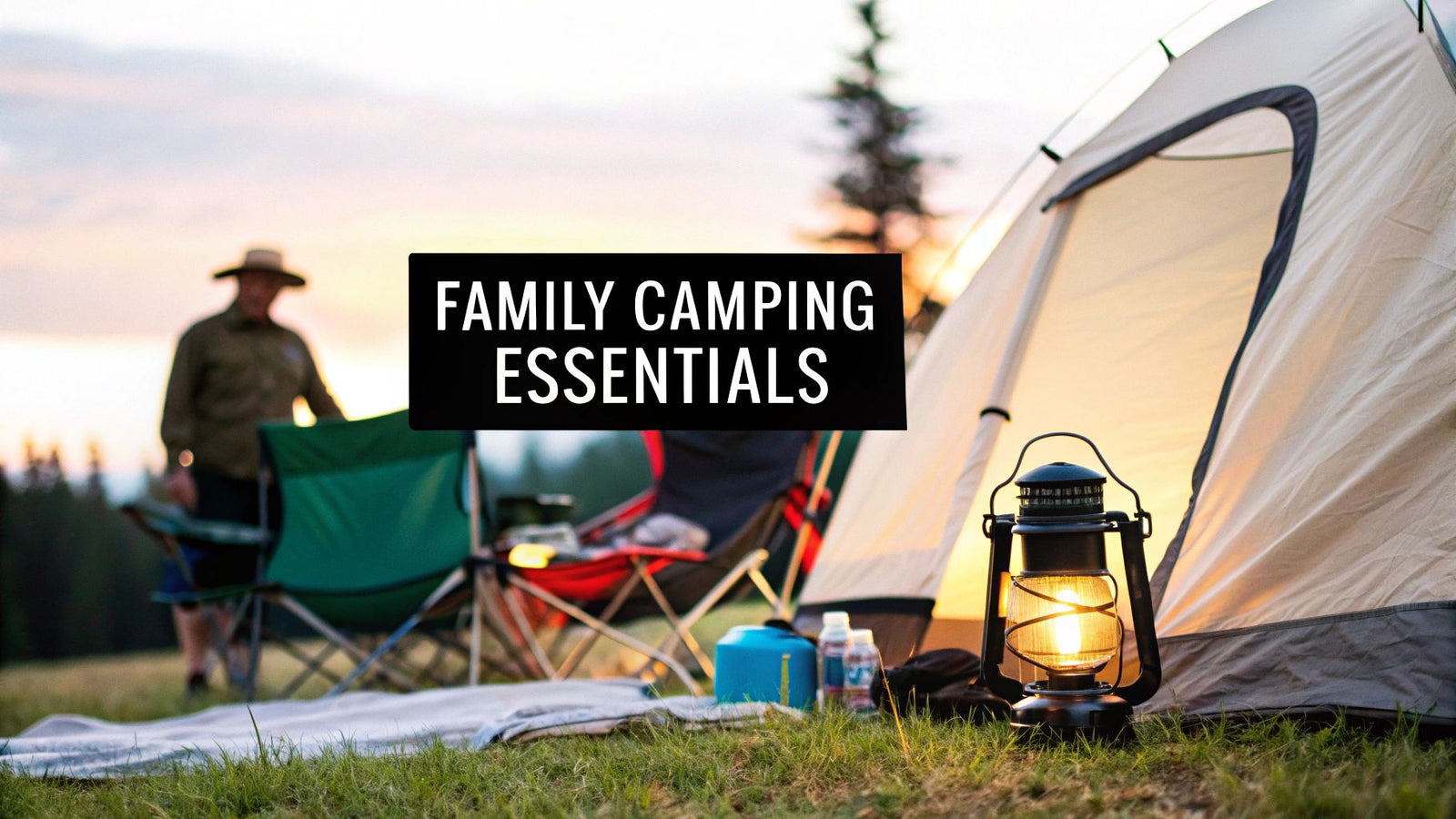
Heading out on a family camping trip is one of the best ways to unplug and make incredible memories, but figuring out what to pack can feel like a massive puzzle. This guide is here to make it simple. We'll break down all the family camping essentials into easy-to-manage categories, from your tent and safety gear all the way to your camp kitchen. Think of it as your roadmap to a fun, stress-free adventure.
Your Family Camping Adventure Starts Here
Good planning is the secret sauce for a great trip, turning what could be chaos into those perfect, peaceful moments under the stars. When you focus on the big three—comfort, safety, and fun—you can pack with total confidence. And you're not alone! A recent industry report revealed that in 2022 alone, over 6.5 million U.S. households camped for the very first time.
That huge jump in people heading outdoors really shows why having a solid plan is so important. A well-organized checklist makes sure nothing crucial gets left in the garage.
The Core Pillars of Camping Success
The trick is to think in categories. When you group your gear into manageable chunks, the whole process feels less overwhelming, and you're less likely to forget something. For example, keeping all your cooking supplies in one bin makes whipping up dinner a breeze, while having a dedicated first-aid kit means you're always ready for anything.
This diagram lays it all out, showing how the main categories of shelter, kitchen, and safety gear are the foundation for everything else.
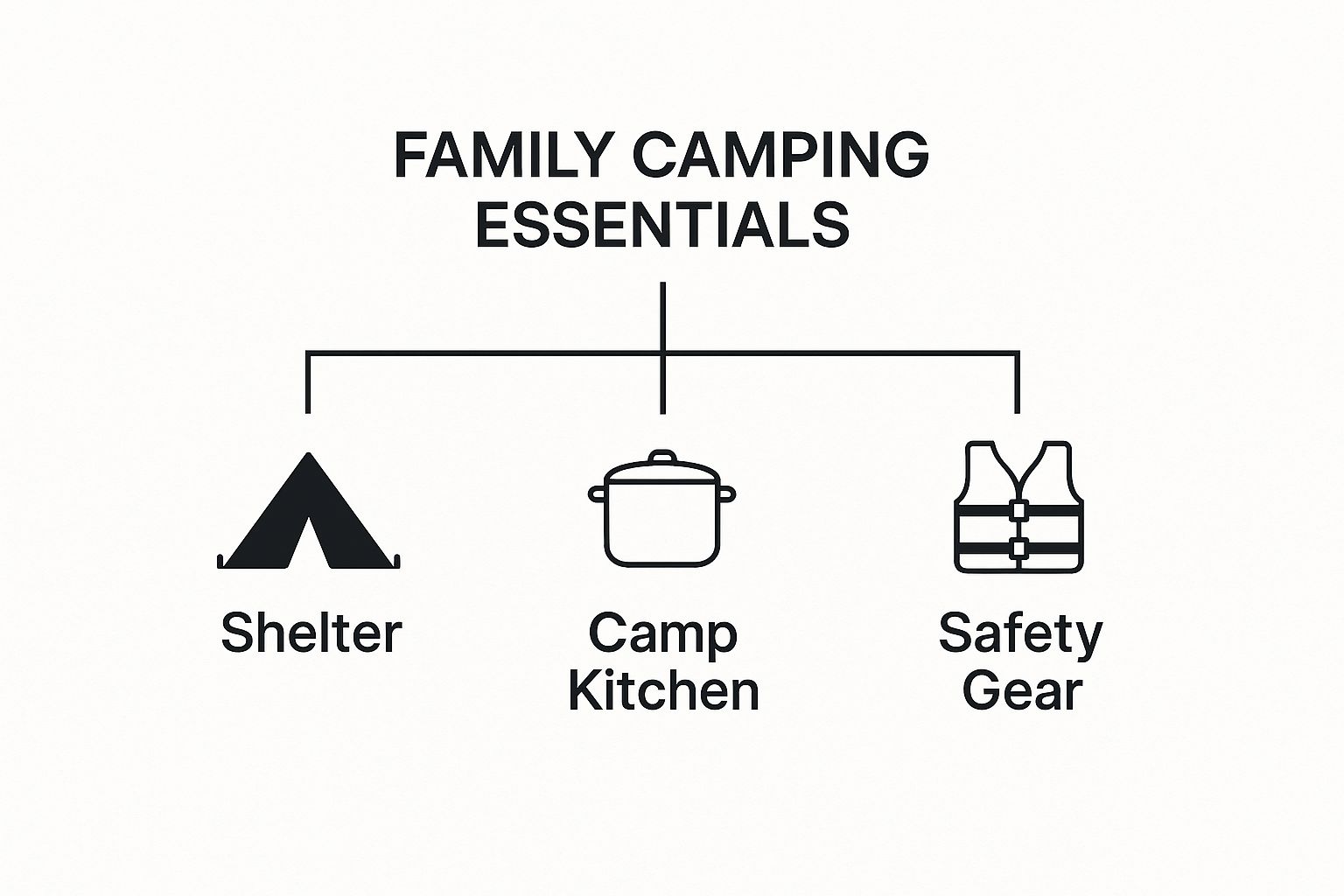
Seeing your gear this way helps you focus on what you absolutely need for a safe and comfortable base camp.
Smart, space-saving gear is your best friend when packing for a family. It allows you to bring everything you need without overloading your vehicle. Items that serve multiple purposes or collapse down are especially valuable.
Take hydration, for example. It's non-negotiable, but those giant, rigid water jugs eat up a ton of precious cargo space. This is where modern gear makes a real difference. A HYDAWAY Collapsible Water Jug provides 1.5 gallons of water for cooking and cleaning at camp, then flattens down to just over an inch thick for the trip home. Check out our guide on collapsible water containers for camping to see how you can stay hydrated without the bulk—it's the perfect example of packing smarter, not harder.
Building a Comfortable Campsite Shelter
A good night's sleep can make or break a camping trip. Seriously. It's the difference between waking up refreshed and ready for adventure, or stumbling out of the tent groggy and grumpy. Your shelter is your home away from home, and making it a secure, restful space is priority number one. This all starts with the right tent—your family's basecamp for the whole trip.
The foundation of your campsite is, of course, the tent. There's a reason the global outdoor family camping tent market is seeing such a boom—it's expected to grow to $4.1 billion by 2030 as more families discover the magic of sleeping under the stars. This growth is fueled by some amazing innovations that make today's tents more durable, spacious, and way easier to set up than the clunky models of the past.
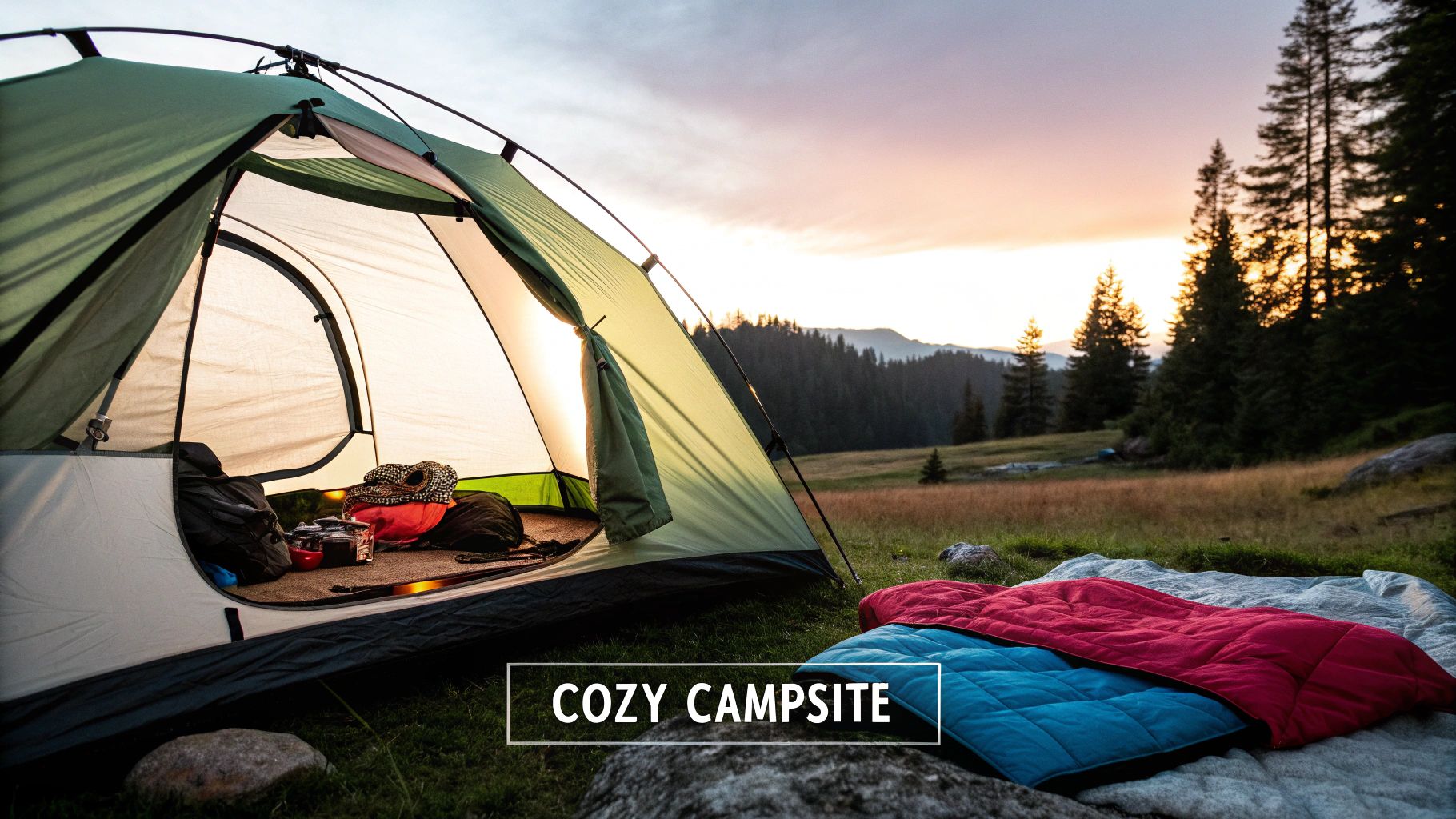
Choosing Your Family Tent
When you're looking at tent sizes, think of the capacity rating as a friendly suggestion, not a hard rule. A "6-person" tent is often the sweet spot for a family of four. This gives you enough room for everyone's sleeping bags plus a corner for duffel bags and gear. Without that buffer, things can get chaotic and cramped in a hurry, especially with kids.
For family camping, you'll mostly see two popular styles:
- Dome Tents: These are fantastic all-rounders. They give you a good balance of interior space and stability, holding up well if the wind picks up. Their simple pole design usually means a quick, painless setup.
- Cabin Tents: With their nearly vertical walls, these tents are all about maximizing headroom. Most adults can stand up straight inside, which is a game-changer for changing clothes or just moving around. It's a little luxury that makes a huge difference on longer trips.
When you're trying to decide, think about your family's needs. Are you a quick-setup-and-go crew, or do you prefer a more spacious, home-like feel for your campsite? The table below breaks down the key differences to help you choose the perfect tent for your adventures.
Family Tent Feature Comparison
| Feature | Dome Tent | Cabin Tent | Backpacking Tent |
|---|---|---|---|
| Headroom | Best in the center, slopes at sides. | Excellent, near-vertical walls. | Very limited, designed for sleeping only. |
| Weather Resistance | Aerodynamic shape is great in wind. | Can act like a sail in high winds. | Low profile excels in harsh weather. |
| Ease of Setup | Typically very simple and fast. | Can be more complex with more poles. | Ultra-simple, focused on speed. |
| Weight | Moderate, good for car camping. | Heaviest option, for car camping only. | The lightest option, for carrying long distances. |
| Best For | Weekend trips, small families, windy areas. | Longer stays, large families, comfort lovers. | Minimalist campers, hiking trips, solo use. |
Ultimately, both dome and cabin tents are solid choices for family outings. Your decision will likely come down to balancing interior comfort with performance in different weather conditions.
Creating a Cozy Sleep System
Once your tent is pitched, the next layer of comfort is your sleep system. This isn't just about your sleeping bag; it's the combination of a sleeping pad and a sleeping bag working together.
A sleeping pad does more than just cushion you from rocks and roots. Its main job is to insulate you from the cold, hard ground, which sucks warmth away from your body. For families, self-inflating pads are a fantastic, durable option that provides a great mix of comfort and warmth.
Sleeping bags are just as vital. Always, always check the temperature rating and pick one that’s right for the nighttime lows you expect on your trip. A bag that’s too hot or not warm enough is a surefire recipe for a restless night.
A simple trick to create a comforting, soft glow inside the tent is to wrap a headlamp around a water bottle. Instead of a bulky lantern, this DIY solution provides just enough ambient light for kids to feel secure without being too bright.
This is a perfect example of how multi-purpose items can save precious space. A HYDAWAY Collapsible Bottle, for instance, serves as your hydration source during the day and your lantern base at night. To see more ways you can pack lighter without sacrificing function, check out our complete ultralight camping gear list for more tips and tricks. By thinking creatively, you can make sure every single piece of gear pulls its weight.
Setting Up Your Campsite Kitchen
Let's be honest, amazing food can take a camping trip from good to unforgettable. Your camp kitchen is more than just a place to cook; it's the heart of your campsite. It’s where you’ll sip coffee as the sun comes up and gather for s’mores under the stars. Getting this space organized and efficient is the secret to a happy, well-fed family.
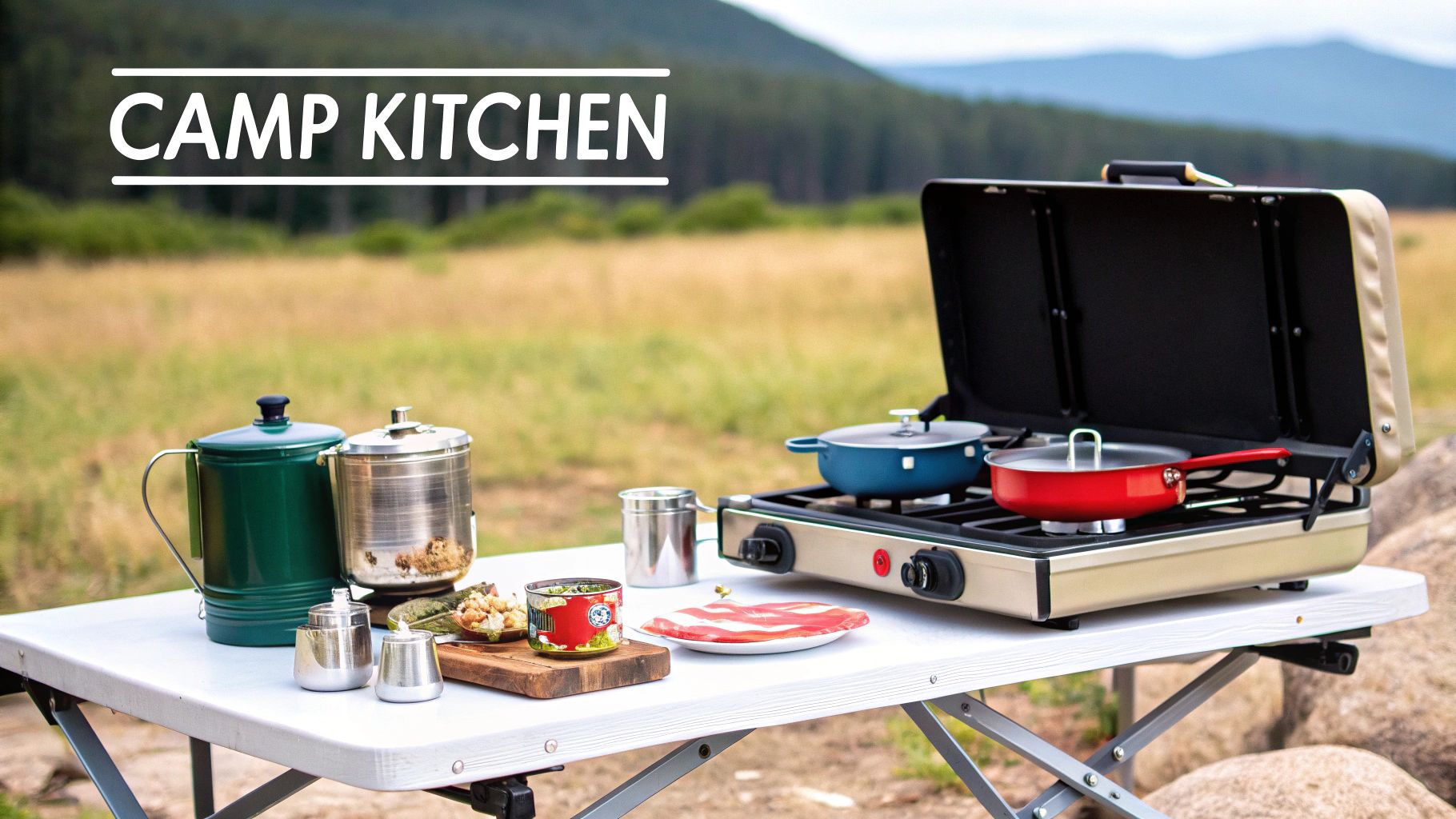
It seems like more and more families are discovering the magic of the outdoors. The global camping and caravanning market, currently valued at over $50 billion, is projected to keep growing. This boom shows just how much people crave these kinds of experiences, making smart gear choices more important than ever.
Core Cooking and Hydration Gear
The absolute cornerstone of any camp kitchen is a reliable two-burner propane stove. It gives you the freedom to boil water for pasta on one burner while simmering chili on the other, just like you would at home. You’ll also want a basic cookware set—a cast-iron skillet is a nearly indestructible workhorse, perfect for everything from morning pancakes to searing freshly caught fish.
And for that classic campfire vibe? Exploring the best BBQ fire pits can really elevate the whole experience, giving you a perfect spot for cooking and staying warm.
Just as important is your water situation. Lugging around a bunch of bulky, rigid gallon jugs is a real pain and a massive space-waster. This is where HYDAWAY’s collapsible gear completely changes the game. Use a large-capacity HYDAWAY Collapsible Water Jug for all your cooking and washing needs at camp. Then, when it’s time for a hike, everyone can grab their own personal-sized Collapsible Bottle. They work perfectly when you need them and pack down flat when you don’t.
Cooler packing is an art form. Freeze water bottles to use as ice packs—they'll keep food cold and give you drinking water as they thaw. Layer your cooler with frozen items on the bottom, perishable foods in the middle, and delicate things like eggs right on top.
A Simple Three-Day Meal Plan
To show you how easy this can be, here’s a kid-approved meal plan that keeps things simple and fun. The key is to do as much prep at home as possible to minimize your work at the campsite. For more smart packing ideas, check out our guide on collapsible camping cookware.
Day 1
- Breakfast: Granola, yogurt, and fresh berries. No cooking required!
- Lunch: Pre-made sandwiches or wraps. Easy to grab and go.
- Dinner: Foil-packet dinners. This is a classic for a reason! Let everyone build their own with sliced sausage, potatoes, carrots, and onions. Just wrap them in foil and toss them in the campfire coals for a fun, interactive meal.
Day 2
- Breakfast: "Pancakes in a bottle." Mix your batter at home and pour it into a clean squeeze bottle. It makes for a super easy, mess-free breakfast.
- Lunch: Leftover foil-packet meals or hot dogs roasted over the fire.
- Dinner: One-pot pasta. All you need is a pot, some marinara sauce, and pre-cooked meatballs. Simple, hearty, and minimal cleanup.
Day 3
- Breakfast: Scrambled eggs and toast, cooked right on your skillet.
- Lunch: "Walking Tacos." Serve taco meat in individual bags of corn chips and top with cheese and salsa. Kids love this one.
- Dinner: A simple meal of grilled cheese and tomato soup before you start packing up. It's the perfect cozy end to a great trip.
Dressing for the Elements and Staying Safe
Unpredictable weather is just part of the camping adventure, but being unprepared can turn a great trip sour in a heartbeat. The single best strategy for keeping everyone comfortable—especially kids, who seem to have a broken internal thermometer—is dressing in layers.
Think of it like building a personal climate control system for each person. The concept is simple but incredibly effective. You start with a moisture-wicking base layer to pull sweat off the skin, add an insulating mid-layer like a fleece for warmth, and top it all off with a waterproof and windproof outer layer. This setup lets you add or shed pieces to perfectly match the conditions, preventing anyone from getting chilled or overheating.
Your All-Weather Apparel Checklist
Having the right clothing isn't just nice—it's non-negotiable. Sturdy, closed-toe shoes are a must for exploring, and a quality rain jacket for every family member can absolutely save the day when a surprise shower rolls through. Never, ever underestimate how cold it can get at night, even after a perfectly warm day.
Keeping everyone’s feet warm is especially important. Cold toes can ruin a good time faster than anything, so check out these proven tips for keeping feet warm in winter to head off any discomfort, especially for the little ones.
Here's a quick checklist to guide your packing:
- Footwear: Waterproof hiking boots or at least a pair of sturdy sneakers.
- Socks: Multiple pairs of wool or synthetic socks. Just say no to cotton!
- Base Layers: Moisture-wicking long-sleeved shirts and leggings.
- Mid-Layers: Fleece jackets, puffy vests, or your favorite warm sweaters.
- Outer Layers: Waterproof and windproof rain jackets and rain pants.
- Extras: A warm beanie, sun hats, and gloves for everyone.
This combo prepares you for just about anything: chilly mornings, sunny afternoons, and those unexpected downpours.
Assembling a Family-Focused First-Aid Kit
Beyond dressing for the weather, being ready for the inevitable scrapes, stings, and splinters is crucial for your peace of mind. You can buy a pre-made kit, but I always recommend customizing one for your family’s specific needs. A well-stocked kit means you can handle small issues confidently without having to pack up and go home.
Start with the basics like bandages of all sizes, antiseptic wipes, and gauze. Then, think about the unique challenges of being outdoors.
A great family first-aid kit goes beyond just bandages. It should include items to treat the most common outdoor ailments, from bug bites and sunburn to minor allergic reactions, making you a prepared and confident camp leader.
For instance, a reliable insect repellent is your first line of defense against itchy bites. Broad-spectrum sunscreen is another must-have to protect everyone from getting fried. And don't forget to pack any personal medications, like allergy relief for seasonal sniffles or an EpiPen if someone in your family needs one. This kind of prep empowers you to manage minor mishaps with ease.
Finally, a pro tip: everyone in the family, including the kids, should have their own headlamp. This isn't just for late-night bathroom trips; it's a critical safety item that gives kids a little independence and ensures no one is ever left fumbling in the dark. Toss in a sturdy multi-tool for unexpected repairs, and your safety gear is complete. Now you can relax and focus on making memories.
Adding Comfort and Fun to Your Campsite
Okay, you’ve got the basics covered—shelter, food, and safety are all checked off the list. Now it’s time for the fun stuff. The little extras are what take a campsite from just a spot in the woods to a cozy outdoor living room, setting the stage for some serious memory-making. These are the family camping essentials that shift the experience from just surviving outside to thriving out there.
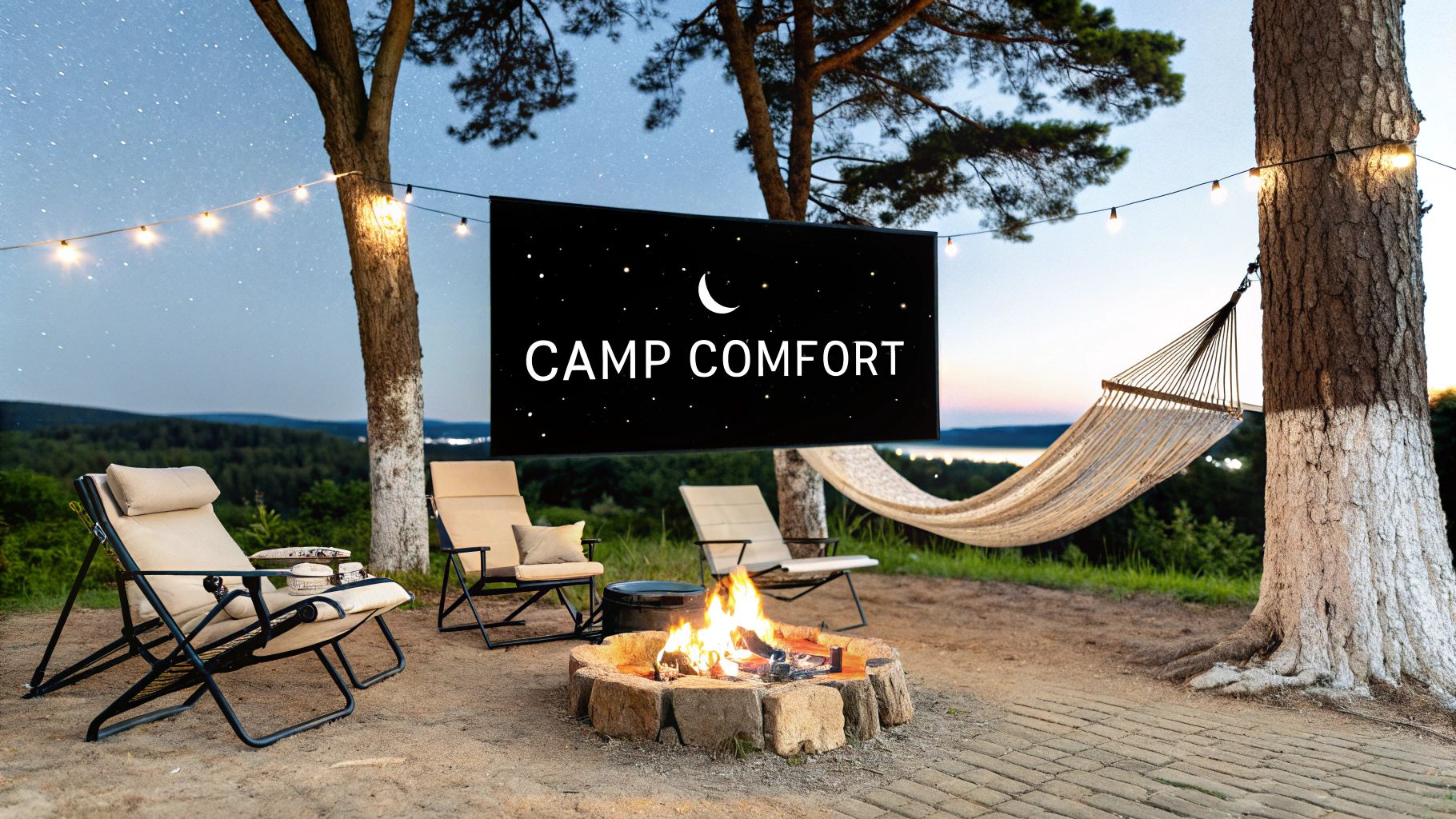
It all starts with creating an inviting central hub. A simple portable folding table becomes your command center for everything, from chopping veggies for dinner to dealing out a late-night game of cards. Throw in a comfy camp chair for every family member, and you’ve created a space where everyone actually wants to hang out, relax, and connect.
Creating Campsite Ambiance and Relaxation
Good lighting and comfortable seating are the secret ingredients to a great campsite vibe. Once the sun dips below the horizon, stringing up a few solar-powered lanterns or battery-operated fairy lights can make your spot feel downright magical. That ambient glow is so much warmer and more pleasant than the harsh, focused beam of a single headlamp.
Another game-changer for relaxation? A hammock. It’s a simple addition that pays off big time. Tucked between two sturdy trees, it’s the perfect spot for an afternoon nap, a quiet hour with a book, or just watching the clouds drift by. A small item that delivers a huge upgrade in comfort.
Beyond the basic gear, the best campsites are defined by their ability to foster connection and fun. Investing in a few simple items for comfort and entertainment ensures that screen-free time is engaging for everyone.
This philosophy of making things easy and comfortable should apply to every member of the family—even the four-legged ones. Instead of lugging a clunky, rigid water dish, a HYDAWAY Collapsible Pet Bowl is the perfect solution. It makes sure your furry sidekick stays hydrated without hogging precious space in your gear bin, collapsing totally flat when not in use.
Screen-Free Fun for the Whole Family
Let’s be honest, one of the best parts of camping is watching your kids entertain themselves without a screen in sight. The trick is to pack a small "fun kit" filled with engaging, low-tech options that get them exploring and playing in the world around them.
Here are a few ideas to get you started:
- Nature Exploration Tools: A pair of binoculars, a magnifying glass, and a bug-catching kit can turn a simple walk through the trees into a full-blown scientific expedition.
- Simple Games: You can't go wrong with a frisbee, a football, or a classic deck of cards. Games like Uno, Exploding Kittens, or Taco Cat Goat Cheese Pizza are always a huge hit and are perfect for playing around the picnic table.
- Creative Activities: Toss in some nature-themed coloring books or start a family tradition of telling spooky (or silly) stories around the campfire. A simple scavenger hunt can easily keep kids busy for hours.
When you thoughtfully pack for comfort and fun, you guarantee your campsite becomes a place where your family can unplug from the day-to-day and truly reconnect—with each other and with the great outdoors.
Answering Your Family Camping Questions
Even with the best checklist in the world, you’re still going to have questions. What-ifs are just part of the deal, especially when you’re new to this whole family camping thing. This is where we tackle some of the most common worries parents have, giving you practical, field-tested answers so you can pack with confidence and handle whatever the trail throws at you.
How Can I Keep My Kids Comfortable and Sleeping Through the Night?
A kid who sleeps well means everyone sleeps well. It’s that simple. The trick is to create a sleep space that feels both warm and familiar, even in a brand-new environment. A favorite pillow or a small, worn-in blanket from their own bed can work wonders.
Make sure their sleeping pad offers plenty of insulation from the cold ground—this is just as critical as the sleeping bag itself. A common mistake is piling on too many layers inside the bag. All they really need is a simple base layer of fleece or wool; the sleeping bag is designed to trap their body heat, and too many clothes can actually make them sweat and get cold.
A soft, battery-powered night light or a headlamp on its dimmest red setting can also provide a comforting glow if they wake up in the dark. It’s a small touch that offers a huge amount of reassurance.
What Are the Best Space-Saving Packing Tips for a Family?
Ah, the classic game of car Tetris. Winning this game is all about choosing gear that’s either multi-purpose or can shrink when you’re not using it. Compression sacks are your best friends here—they’re non-negotiable for squishing down sleeping bags and extra clothes into surprisingly small packages.
This is also where collapsible gear becomes your MVP. Instead of hauling bulky, rigid water jugs and food containers, HYDAWAY's collapsible bottles and food storage give you everything you need at camp, then flatten down to almost nothing for the drive. For example, packing four 25oz rigid bottles takes up significant space, but four HYDAWAY Collapsible Bottles pack down to the size of one, freeing up a mind-boggling amount of room.
Want to save even more room? Repackage all your food before you leave. Ditch the bulky cereal boxes and pasta packages. Instead, portion everything into reusable, clearly labeled zip-top bags. It’s a simple move that makes your food bin way more organized and compact.
What Are Some Easy and Fun Meal Ideas for Camping with Kids?
The best kid-friendly camping meals are simple, a little interactive, and definitely delicious. You can’t go wrong with "walking tacos." Just cook the taco meat at home, and at the campsite, serve it up in individual bags of corn chips. Let the kids add their own cheese and salsa—it’s fun, contained, and cleanup is a breeze.
Foil packet dinners are another guaranteed win. Pre-chop sausage, potatoes, and other veggies at home. At camp, let each kid build their own packet, wrap it tight in foil, and toss it in the campfire embers to cook. For breakfast, mixing pancake batter at home and storing it in a squeeze bottle makes for a quick, no-mess morning that kids absolutely love.
How Do I Manage Waste and Teach My Kids About Leave No Trace?
Teaching your kids to respect the outdoors is one of the most lasting gifts of camping. Start by introducing the Leave No Trace principles with a motto they can easily remember: "Leave our campsite cleaner than we found it."
Get them involved right from the start. Have them help you remove extra packaging from food before you even leave the house. At the campsite, set up clearly marked bags for trash and recycling, and always lock them in your car at night so you don’t get any four-legged visitors.
Before you head home, make a game out of the final "campsite sweep." Everyone works together to pick up any missed wrappers or tiny bits of trash. It turns a chore into a rewarding team effort and a powerful lesson.
Ready to change how you pack and hydrate on your next family adventure? The HYDAWAY collection of collapsible, space-saving gear is designed to make your trips easier and more sustainable. Ditch the bulk without sacrificing performance. Explore the full collection of collapsible bottles, bowls, and more at myhydaway.com and discover how much space you can really save.



